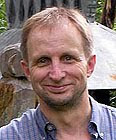
Another article amongst the file of papers I found in one of my unopened packing boxes in my spare room contained a story I wrote for my company's in-house staff magazine called Over The Threshold in their Spring 1995 edition. I was working for the Cheltenham & Gloucester Building Society at the time and I had just made my first-ever visit to Cambodia the previous November. Here's the article, for posterity sake and before I lose it.
Cambodia - a land of charm and cruelty : by Andy Brouwer (Deeds)
The name of Cambodia is synonymous with the cries of the tortured and starving, and more recently the murder of western tourists by the genocidal Khmer Rouge, responsible for the deaths of over one million of their fellow countrymen in the late 1970s. That country was, however, my choice of destination for a week's break from the rigours of C&G life at Chief Office in late October [1994].
Cambodia, racked by civil war for the last 25 years, is one of the world's poorest countries with a population of nine million, the majority of whom live in abject poverty by western standards. Conversely, it is also a beautiful country with a fascinating culture and people, and a history brought vivdly to life by one of the world's greatest architectural achievements - the temple ruins of Angkor.
Undoubtedly, the highlight of my trip was the three days I spent exploring the dramatic ruined cities of Angkor Wat and Angkor Thom. Flying in from Phnom Penh, the capital, to the northern provincial centre of Siem Reap, I was unprepared for the awesome array of massive stone temples, wide majestic causeways, imposing towers and gates and beautifully intricate stone carvings which I encountered.
The monuments were originally constructed by a dozen Khmer god-kings between the 9th and 13th centuries, but had lain hidden by dense jungle for nearly 500 years until their rediscovery by the French in the latter part of the last century. Along with my guide, Soy Bun, and driver, Somath, I wandered leisurely for hours among the near deserted ruins before completing a whistle-stop tour of the lesser visited outer-lying temples.
For sheer size, the vast spectacle of Angkor Wat, the largest religious edifice in the world, is simply stunning. Its central tower, surrounded by four smaller towers, a myriad of galleries and covered passageways and an 800-metre-long series of richly carved bas-reliefs will linger long in the memory, particularly a dawn visit to watch the sun rise, bathing the temple complex in swathes of red and organge light. Perhaps more startling than Angkor Wat, although smaller and less restored, is the Bayon, at the centre of Angkor Thom. Its most intriguing feature - although its bas-reliefs are extraordinarily detailed - are the giant faces of the Bodhisattva Avalokitesvara, with its enigmatic half-smile peering down from all four sides of the 54 towers.
Among the other temples to make a lasting impression were the well-preserved Preah Khan - a labyrinth of fascinating pavilions, halls and galleries - and the temple of Ta Prohm. The latter has been left much as it was when it was rediscovered - a mass of silk-cotton and fig trees, tangled roots and vines, and fallen masonry framing an eerie and haunting scene.
Phnom Penh on the other hand was an altogether different proposition. It is a city in transformation. The once elegant French-colonial capital became a ghost town when the Khmer Rouge forcibly emptied it of all its inhabitants in 1975. Today, many parts of Phnom Penh are undergoing frenzied reconstruction, although life remains unchanged in the city's back alleys, where the majority of the one million populace live in hovels without any basic amenities.
Negotiating the traffic - a multitude of mopeds, cyclos and bicycles jockeying with private cars and trucks - was a nerve-racking experience. The loss of my suitcase at the ramshackle airport for three days was a nightmare. But nothing could prepare me for my sobering visit to the Tuol Sleng Genocide Museum which houses graphic reminders of the cruelty inflicted by the Pol Pot-inspired Khmer Rouge regime. Ten kilometres outside the city are the 'killing fields' of Choeung Ek, where at least 17,000 people were taken from Tuol Sleng, brutally murdered and buried in mass graves. A memorial glass tower at the site is filled with the cracked skulls of some 8,000 of those victims, and is definitely not for the squeamish.
I left Cambodia with many lasting memories, enriched by my experiences and eager to return to this fascinating country in the not too distant future.
 These dancing figures could be termed apsaras, though the one in the middle has a face that resembles someone chewing a wasp
These dancing figures could be termed apsaras, though the one in the middle has a face that resembles someone chewing a wasp This part of the northern outer terrace is in good condition. Note the multi-coloured sections of the wall.
This part of the northern outer terrace is in good condition. Note the multi-coloured sections of the wall. Don't try this at home. A sword swallower tries to impress the King whilst spearing the head of his little friend
Don't try this at home. A sword swallower tries to impress the King whilst spearing the head of his little friend
















































